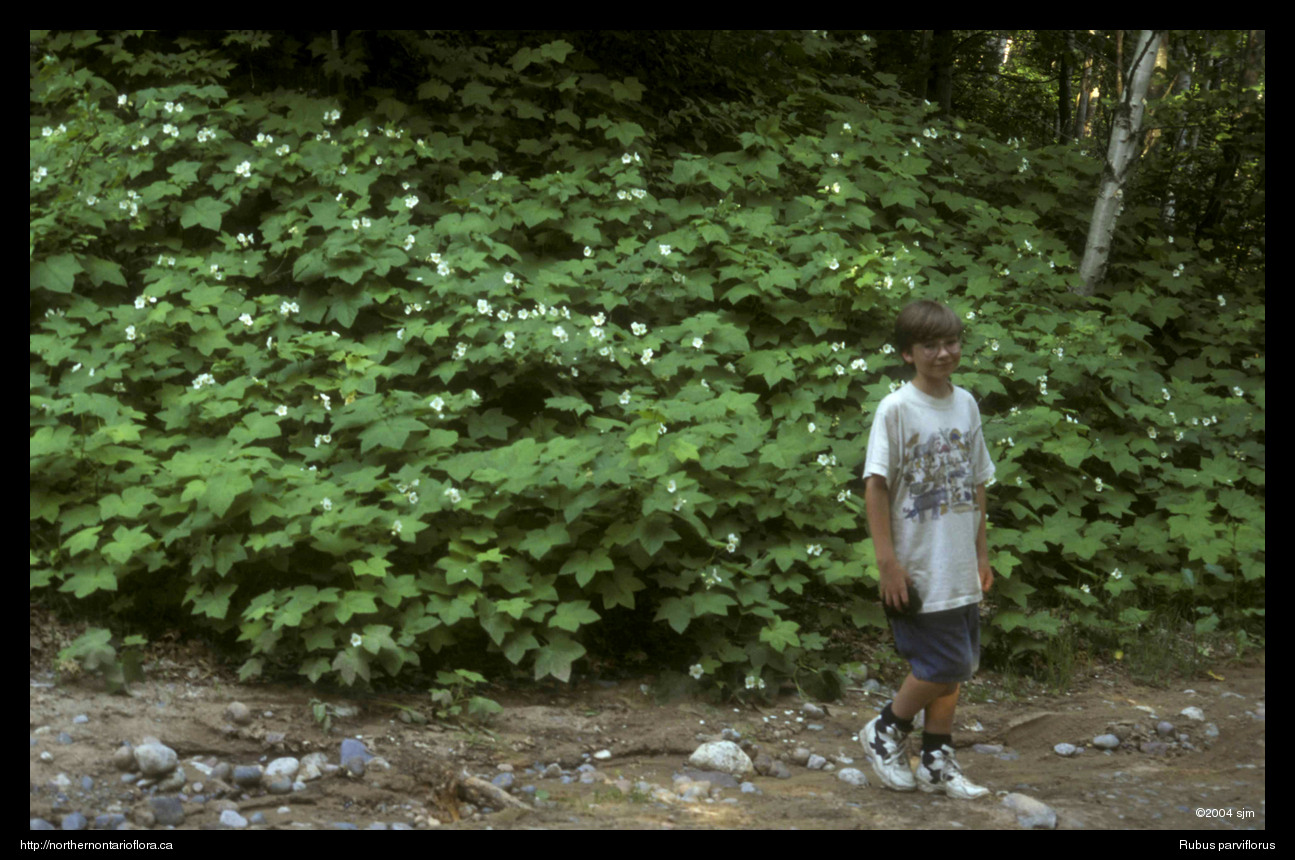
|
Northern Ontario Plant Database 
Plant DescriptionRubus parviflorus Nutt.En: thimbleberry, sparseflowered thimbleberry, whiteflowering raspberry, salmonberry
Rosaceae (Rose Family) General: A perennial, deciduous, erect shrub, 1–2 m tall, with large, maple-like leaves. Dense colonies or thickets often form from underground rhizomes. Older stems reddish-brown to grayish-brown, the bark shredding easily; stems lack bristles and spines; young twigs glandular hairy. The name thimbleberry refers to the thimble-shaped fruits. Leaves: Alternate, simple, thin, palmately-veined, long-petiolate. Leaf blades palmately-lobed, usually with 5 (3–7) ovate-triangular lobes, 10 to 20 cm long and wide; green above, paler beneath; hairy, at least on the lower surface; leaf base cordate; lobe apices pointed (acute); margins coarsely toothed (serrate); leaf stalk (petiole) and stipules glandular-hairy, fused to the base of the petiole. Flowers: Bisexual, but self-incompatible; large, 3–5 cm across, in terminal clusters (cymes) of 1-15 flowers, but usually with only 1–3 flowers blooming at the same time; the long flower stalks (pedicels) are glandular-hairy. Calyx hairy, green, the 5 ovate lobes narrowing to tail-like (caudate) appendages; petals 5, white, obovate, 1.5–2 cm long; stamens numerous; pistils numerous; the styles persistent in fruit. Flowers bloom in mid summer. Fruit: A dome-shaped (hemispherical) raspberry-like fruit, composed of a cluster of small drupes, (an aggregate of drupelets), greenish to pink when young, turning red when mature; 1.5–2 cm in diameter; edible and juicy, but slightly acidic; easily separating from the receptacle. Fruits mature in autumn. Habitat and Range: Moist to dry, shady habitats; shoreline thickets, edges of woods, roadsides. The thimbleberry has a disjunct range (Cordilleran disjunct), occurring in western North America and the Great Lakes region. In Ontario, it grows around the Lake Superior shore, extending south though Manitoulin Island to the tip of the Bruce Peninsula. Similar Species: Rubus odoratus, the purple-flowering raspberry, is similar in form and leaf shape to the thimbleberry, but is easily identified by its reddish-purple petals and the leaf shape, in which the 3–5 lobes of the leaf are longer and sharply pointed (acuminate); the fruits are dry and inedible. In Ontario, natural populations of the purple-flowering raspberry are restricted to southern Ontario and do not overlap with the range of the thimbleberry, though one historical population of Rubus odoratus was reported from the Sault Ste. Marie region in the Shrubs of Ontario (Soper & Heimburger 1982). The webpage of Rubus odoratus is from the Gallery of Connecticut Wildflowers, a website of the Connecticut Botanical Society. See also the Rubus parviflorus webpage from the Virginia Tech Dendrology website. Back to species list |
||||||||||||||||||||||










